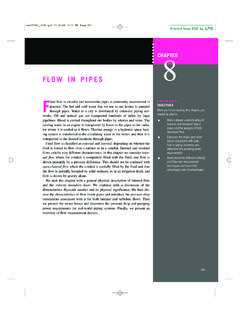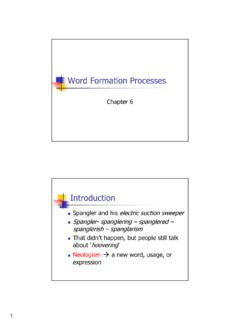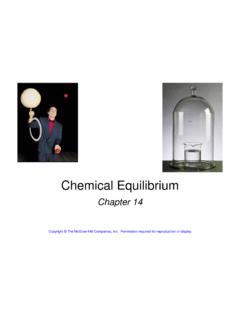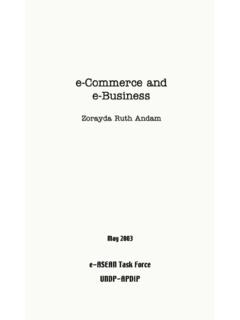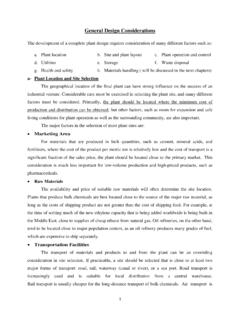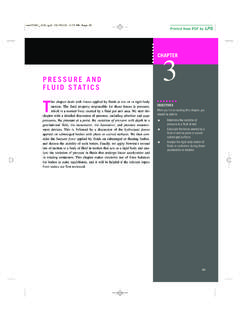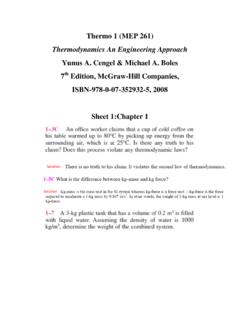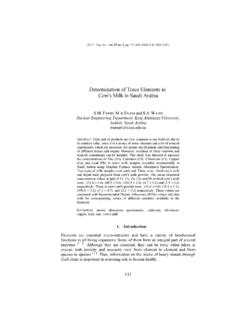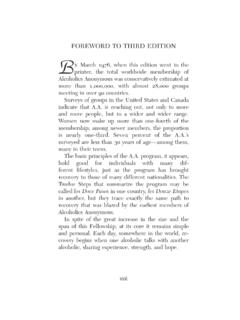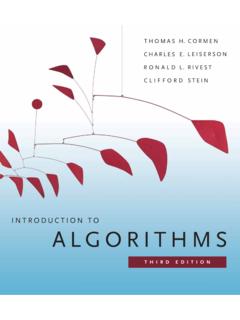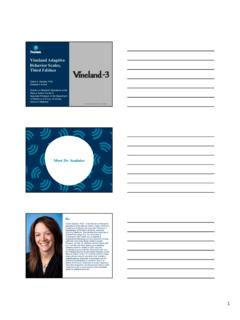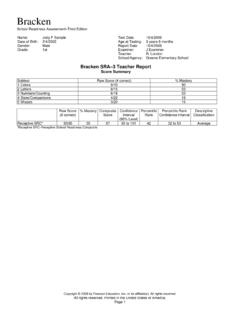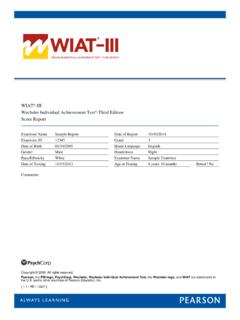Transcription of Academic Writing: A Handbook for International …
1 Academic writing Most International students need to write essays and reports for exams andcoursework. Yet writing good Academic English is one of the mostdemanding tasks students face. This new edition of Academic Writinghasbeen fully revised to help students reach this goal. Clearly organised, thecourse explains the writing process from start to finish. Each stage isdemonstrated and practised, from selecting suitable sources, reading, note-making and planning through to re- writing and four main parts of Academic Writingallow teachers and students toeasily find the help they need. Each part is divided into short sections,which contain examples, explanations and exercises, for use in the classroomor self-study. Cross-references allow easy access to relevant sections, and afull answer key is featured on the companion third edition of this popular course builds on the success of the earliereditions and responds to suggestions from both students and has become a major concern in higher education, and a specialfeature of Academic Writingis a section on avoiding plagiarism.
2 There arealso units on the key skills of paraphrasing, summarising and book includes sections on crucial areas such as argument, cause andeffect, comparison, definitions and Academic style. Working in groups,dealing with graphs, charts and numbers and giving examples are explainedin detail. Another part deals with accuracy in writing , providing practicewith topics such as vocabulary, conjunctions and prepositions. The finalpart provides a range of writing models of both short and longer essaysand reports. A new companion website offers further practice with a rangeof additional exercises, including International students wanting to maximise their Academic potentialwill find this practical and easy-to-use book a valuable guide to writing inEnglish for their degree Baileyis a freelance teacher and writer of materials for Englishfor Academic Purposes.
3 He has taught International students for manyyears at the University of Nottingham, UK, and has previously worked inthe Czech Republic, Japan, Malaysia and International students have many adjustments to make as they enter British universities andStephen s book makes at least one area of their lives Academic study much moreapproachable. With its straightforward approach and improved layout, it will be a book manystudents will come to regard as an essential companion to their university Dewhirst, Freelance EAP teacher, UKStephen Bailey has produced an excellent new edition of his popular book Academic book presents a great blend of advice and practice. The advice focuses on what isrequired in terms of Academic writing at university. He addresses different types of academicwriting and even includes sample writing texts.
4 The practice breaks down Academic writingby focussing on the language typically required in Academic settings with lots of studentexercises. His book takes the International student writer through the process of academicwriting, moving from understanding Academic writing tasks to using reading sources throughto revising and drafting the final Lindy Woodrow, Director China Education Centre, University of Sydney, AustraliaInternational students and indeed all students should find this book very helpful. It isaccessible to read and engages in an explicit and sharply focused manner with many elementsof the critical use of reading, of writing and of studying. The book usefully explains,exemplifies, and tests understanding. It deals with the problematic areas of plagiarism andgrammatical work, of developing argument and counter argument, and essay expression.
5 Itshould be very useful for International students engaged in Academic Gina Wisker, University of Brighton, UKStephen Bailey's Academic writing is one of the few Academic writing books that deal withcore areas effectively - language, text type, Academic conventions and the writing is done by giving simple explanations, authentic examples and useful practiceopportunities which can either be done in class or as self study. The book appeals to a rangeof levels including pre and in sessional students and equips them with a range of the keylanguage and skills needed to embark on Academic writing in higher education. Fiona Gilbert, Oxford Brookes University, UKThe third edition of Academic writing : A Handbook for International Students will bewelcome by all students new to Academic writing in English-medium colleges and book is carefully set out to guide students step by step through the maze of assignmenttypes, writing conventions and mysterious vocabulary they will find when entering highereducation.
6 Moving from the writing process through common patterns of grammar andargument to models of literature reviews, essays and reports, the Handbook offers a clear,practical and accessible introduction to the skills students will need to write effectively Ken Hyland, University of Hong KongThis book provides International students with a useful introduction to the basic practices inreading and writing for Academic purposes. It includes topics such as the typical content ofarticle abstracts, the mechanics of citation and referencing, and some uses of sources inwriting topics that will help International students, studying in an English medium universityfor the first time, to meet their tutors expectations in reading and writing assignments. Thechapter on reading advises a critical attitude to internet resources, advice most relevant tostudents Chandrasegaran, National Institute of Education, Singapore 1 EEE234567891012 EEE3456222278292012345 EEE678930123456789401236222 Academic WritingA Handbook forInternational StudentsThird editionStephen Bailey First edition published 2003by RoutledgeSecond edition published 2006by RoutledgeThis edition published 2011by Routledge2 Park Square, Milton Park, Abingdon, Oxon OX14 4 RNSimultaneously published in the USA and Canadaby Routledge270 Madison Avenue, New York, NY 10016 Routledge is an imprint of the Taylor & Francis Group, an informa business 2011 Stephen BaileyAll rights reserved.
7 No part of this book may be reprinted orreproduced or utilised in any form or by any electronic, mechanical,or other means, now known or hereafter invented, includingphotocopying and recording, or in any information storage orretrieval system, without permission in writing from the Library Cataloguing in Publication DataA catalogue record for this book is available from the British LibraryLibrary of Congress Cataloging-in-Publication DataBailey, Stephen, 1947 Academic writing for International studies of business/Stephen Bailey. 1st ed. p. bibliographical references and Authorship. 2. Academic writing . 3. Business writing . I. 2011808 .06665 dc222010014023 ISBN13: 978 0 415 59580 3 (hbk)ISBN13: 978 0 415 59581 0 (pbk)ISBN13: 978 0 203 83165 6 (ebk)This edition published in the Taylor & Francis e-Library, purchase your own copy of this or any of Taylor & Francis or Routledge scollection of thousands of eBooks please go to 0-203-83165-9 Master e-book ISBN Contents1 EEE234567891012 EEE3456222278292012345 EEE678930123456789401236222 AcknowledgementsxiTeachers introductionxiiiStudents introductionxvAcademic writing quizxixPart 1 The writing to writing3 The purpose of Academic writing 3 Common types of Academic writing 4 The format of long and short writing tasks 5 The features of Academic writing 6 Some other common text features 7 Simple and complex sentences 8 writing in paragraphs Reading.
8 Finding suitable sources11 Academic texts 11 Types of text 14 Using reading lists 14 Using library catalogues 15 Using library websites to search electronic resources Reading: developing critical approaches19 Reading methods 19 Titles, sub-titles and text features 21 Reading abstracts 22 Fact and opinion 23 Assessing internet sources critically 24 Critical thinking Avoiding plagiarism30 What is plagiarism? 30 Acknowledging sources 31 Degrees of plagiarism 32 Avoiding plagiarism by summarising and paraphrasing 33 Avoiding plagiarism by developing good study habits 35 From understanding titles to planning36 The planning process 36 Analysing essay titles 37 Brainstorming 38 Essay length 39 Outlines Finding key points and note-making43 Note-making methods 44 Finding key points 45 Finding relevant points 46 Effective note-making Paraphrasing 50 The elements of effective paraphrasing 50 Techniques for paraphrasing Summarising56 What makes a good summary?
9 56 Stages of summarising References and quotations62 Why use references? 62 Citations and references 63 Reference verbs and systems 64 Using quotations 65 Organising the list of references Combining sources72 Mentioning sources 72 Taking a critical approach 73 Combining three sources Organising paragraphs77 Paragraph structure 77 Development of ideas 80 Linking paragraphs together Introductions and conclusions83 Introduction contents 83 Introduction structure 84 Opening sentences 86 Conclusions Re- writing and proof-reading90Re- writing 90 Proof-reading 93 Confusing pairs 96viContents Part 2 Elements of Argument and discussion101 Discussion vocabulary 101 Organisation 102 The language of discussion 105 Counter-arguments 106 Providing evidence Cause and effect109 The language of cause and effect Cohesion115
10 Reference words 115 Preventing confusion Comparisons119 Comparison structures 119 Forms of comparison 121 Using superlatives Definitions126 Simple definitions 126 Complex definitions Examples130 Using examples 130 Phrases to introduce examples 131 Restatement Generalisations134 Using generalisations 134 Structure 135 Building on generalisations Numbers139 The language of numbers 139 Percentages 140 Simplification 141 Further numerical phrases Problems and solutions145 Structure 145 Vocabulary Style150 Components of Academic style 150 Guidelines 1521 EEE234567891012 EEE3456222278292012345 EEE678930123456789401236222viiContents Avoiding repetition and redundancy 154 Varying sentence length Visual information158 The language of change 158 Types of visuals 159 Describing visuals 162 Labelling Working in groups166 Why work in groups?
